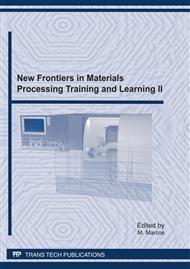p.24
p.33
p.42
p.50
p.58
p.65
p.74
p.83
p.93
Implementation of Simulation Software for Better Understanding of Manufacturing Processes
Abstract:
The adaptation of universities to the European Higher Education Area (EHEA) plays an essential role in society, creating new knowledge, transferring it to students by means of new and more active methodologies aimed at learning that will enable students to put everything they learn into practice. However, such methodologies are not equally applicable in all subjects. Subjects such as Manufacturing Technology, taught at different levels in both undergraduate and graduate levels, are descriptive to a great extent. This descriptive nature must be supported by new technologies if these subjects claim to be more attractive to students. In this paper some examples of successful case studies are presented. They represent the new way of understanding the teaching replacing the old concept of traditional classroom lecture by more interactive ones and, therefore, more attractive to students.
Info:
Periodical:
Pages:
58-64
Citation:
Online since:
July 2011
Price:
Сopyright:
© 2011 Trans Tech Publications Ltd. All Rights Reserved
Share:
Citation:


